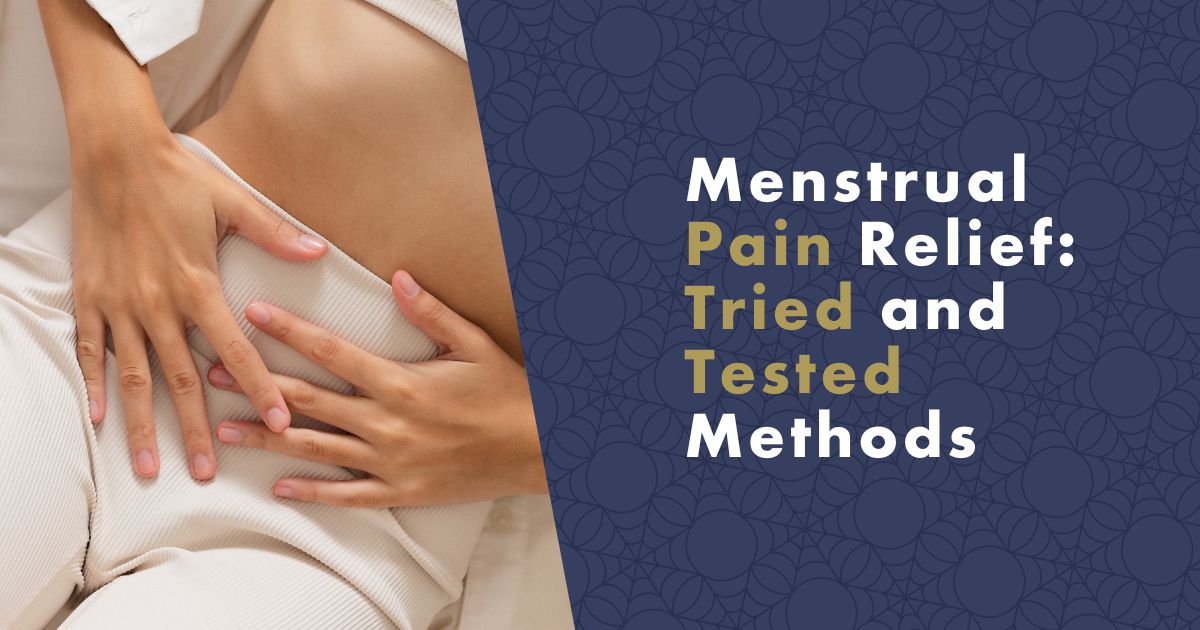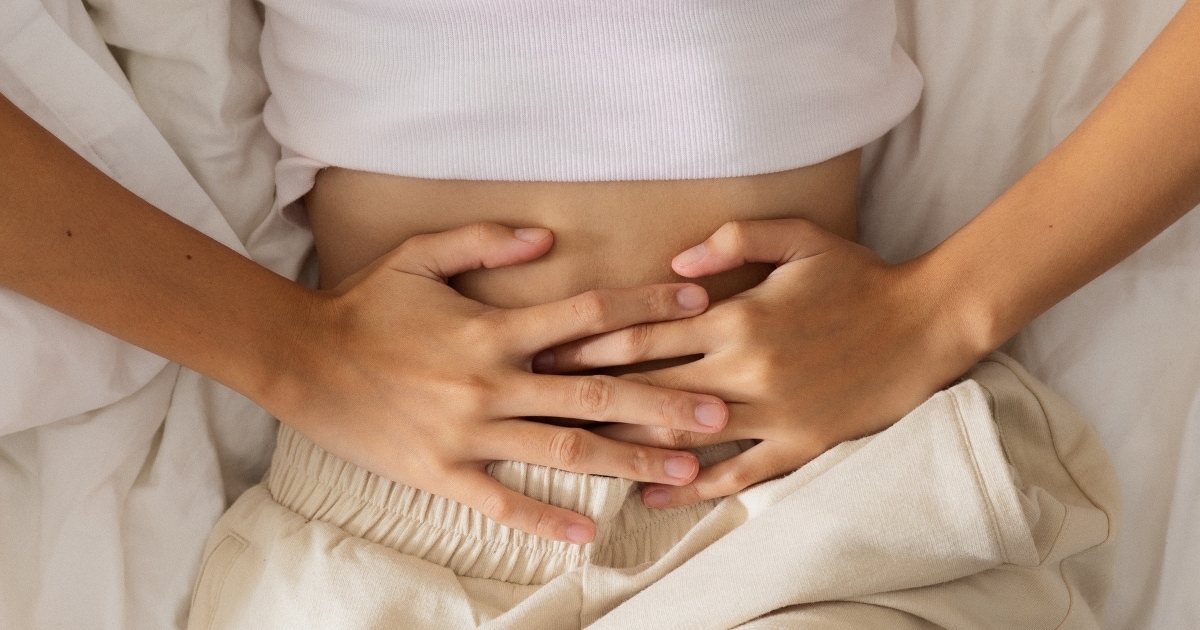Although we may not want to hear it, menstrual pain and menstrual cramps are a common and normal part of our menstrual cycle, experienced by more than half of women every month for one to two days. Let's take a look at what causes the pain, how it can manifest, and what effectively helps with it. We will also discuss when you should seek medical attention.

What Causes Menstrual Pain and Menstrual Cramps?
Menstrual pain occurs when the muscular wall of the uterus contracts. Mild contractions constantly occur in the uterus, but they are usually so mild that most women do not feel them. During menstruation, the uterine wall begins to contract more strongly to help shed the uterine lining as part of menstruation. When the uterine wall contracts, it compresses the blood vessels lining the uterus. This temporarily interrupts blood flow and, with it, oxygen, causing increased pain.
An increased level of prostaglandins, substances similar to hormones that act locally in various organs, is associated with the onset of menstrual pain. Prostaglandins in the uterus are responsible for the strength of its contractions and, consequently, for the pain.
It is not known why some women suffer from menstrual pain more than others, but it is often hereditary. Younger women tend to experience more pain, it often lessens after childbirth, and sometimes even disappears. Menstrual pain can also occur due to certain illnesses. If you experience severe pain that disrupts your normal routine for several days, consult your gynecologist.
Most Common Menstrual Pain - Lower Abdominal Pain
Lower abdominal pain during menstruation is caused by contractions of the uterus, which are trying to expel the shedding uterine lining.
What Worsens Menstrual Pain:
- Stress
- Smoking
- Caffeine
- Unbalanced diet
- Magnesium deficiency
- Some illnesses
Menstrual Pain can Include:
- Lower abdominal pain
- Pain in the lower back and pelvic area
- Diarrhea
- Constipation
Other possible complications may include:
- Urination problems
- Vomiting
- Dizziness and headaches
Tip: What Helps with Headaches and Migraines
What is PMS (Premenstrual Syndrome)
PMS stands for premenstrual syndrome and affects 90% of menstruating women. PMS begins several days before the start of menstruation and continues for the first one or two days of menstruation. Doctors believe that PMS is caused by a drop in estrogen and progesterone levels before each menstruation. PMS is characterized by fatigue, irritability, and painful menstruation.
What is PMDD (Premenstrual Dysphoric Disorder)
Premenstrual Dysphoric Disorder is a more severe form of PMS that affects about 5% of menstruating women. Doctors are not sure what causes PMDD, but women with high levels of stress, depression, or a family history of depression are likely to experience it. PMDD symptoms are similar to PMS but more intense, including more painful cramps.
When to See a Doctor for Menstrual Pain
Visit your healthcare provider if:
- Menstrual cramps disrupt your normal life.
- Your pain worsens every month.
- You have never had pain, but it has started after 20 or more years.
What Else Can Severe Menstrual Pain Indicate?
Although menstrual pain is entirely common, if it is affecting your normal life, it may indicate more serious conditions:
Uterine Fibroids
Uterine fibroids are noncancerous growths that develop in the smooth muscle of the uterus and are found in approximately 40% of women, especially in the age group up to 50 years. They usually appear during the reproductive years and often shrink or disappear after menopause.
Although fibroids are such a common condition, it is still not possible to definitively determine why they develop. Scientists believe that estrogen and progesterone levels play a role, but it has been scientifically ruled out that contraception is to blame.
Heredity and being overweight have a significant impact. Since fibroids grow in the uterine lining, they can cause heavy menstruation and painful menstrual cramps.
Ovarian Cysts on the Ovary
Polycystic ovary syndrome is one of the most common hormonal disorders in women of reproductive age. In our country, the prevalence of this syndrome is around 5% of women. It is defined as a condition with chronic anovulation (chronic lack of ovulation) and an excess of male sex hormones, androgens ("Andros" originates from Greek and means "man.").
Ovarian cysts develop in the ovaries, typically during ovulation. Many women have at least one small cyst each month that naturally disappears. However, some women have multiple or large ovarian cysts that can cause pain or complications. In these cases, medical treatment may be required.
One of the causes is hormonal imbalance, specifically the overproduction of androgens, which can lead to, among other things, excessive hair growth in atypical places for women. Symptoms include irregular menstruation, excessive facial and body hair, weight gain, difficulty losing weight, acne, and hair thinning.
Deep Pelvic Inflammatory Disease (PID)
When the uterus and ovaries become infected, it is called pelvic inflammatory disease (PID). Infection usually begins when bacteria from a sexually transmitted infection (STI) enter the reproductive organs. PID can also occur after a surgical procedure. While many women do not experience any PID symptoms, some may experience painful cramps.
What Is Endometriosis?
Endometriosis is the most common gynecological condition in women of reproductive age. Endometriosis occurs when the uterine lining, also known as the endometrium, grows outside the uterus, typically in other parts of your reproductive organs such as the ovaries or fallopian tubes. This causes painful cramps, heavy bleeding, irritation, and inflammation during menstruation. Endometriosis is not only characterized by extremely painful periods but can also lead to pain during sexual intercourse. Another common symptom is traces of blood in the urine.
Unfortunately, endometriosis can lead to infertility. It is estimated that this condition is the cause of infertility in 20-50% of women.
What Is Adenomyosis?
Adenomyosis is a treatable condition where the endometrium grows into the muscular wall of the uterus. The endometrium can affect the entire uterine muscle, but it usually affects a single location. Adenomyosis is a manageable condition but can cause severe cramps. Doctors are not sure what exactly causes adenomyosis, but women who have had children or undergone uterine surgery are more predisposed to develop adenomyosis.
5 Tips to Alleviate Menstrual Pain and Menstrual Cramps:
Most often, we reach for pain relievers like Paralen or other painkillers, but they don't always work quickly enough, and we don't always want to take them multiple times a day. What else can help?
1) Warm Compresses and Pillows
Try proven warm compresses on your abdomen, lower back, or take a warm shower. Heat is particularly helpful for cramps and pain.
2) Exercise
Although it may seem strange and not everyone feels like it, exercise is very effective in reducing menstrual pain. Exercise releases hormones that alleviate pain, and you often forget about the pain during exercise.
Tip: How Does Anti-Odor Sportswear Work?

3) Supplement with Magnesium
Most people suffer from magnesium deficiency, which can worsen menstrual pain on its own. Magnesium deficiency causes greater tension in the muscles and increases the level of prostaglandins, which cause menstrual pain. Those who experience menstrual pain due to magnesium deficiency swear that magnesium is a miracle cure for menstrual pain. Magnesium also helps absorb pain relievers, which is why millions of women around the world reach for it during menstruation.
Tip: Magnesium Deficiency - How to Quickly Replenish It
If you are considering taking magnesium for menstrual pain, it is recommended to choose supplements that are soluble in the mouth, as they enter the body more quickly and efficiently. In addition to magnesium , trying vitamin D is also recommended, as it supports calcium absorption. Similarly, vitamin E and omega-3, which are anti-inflammatory, can help. However, all of these dietary supplements need to be taken every day, not just during your period. If you are taking medication, remember to consult your doctor about consuming dietary supplements.
Tip: Vitamin D Deficiency: How to Supplement It?
4) Drink Suitable Teas
The most suitable tea is yarrow tea, recommended not only for pain but also for heavy bleeding. Melissa and chamomile tea are also suitable.
5) Proper Nutrition Is Key
Avoid coffee and alcohol, which worsen menstrual pain. During your period, you should also avoid white bread and refined sugar. The best diet is a balanced one rich in calcium, magnesium , and iron , and adequate intake of foods containing vitamin C and B.
#produkty#https://www.nanospace.store/vitamin-c/
Menstrual Pain during Pregnancy
Women sometimes experience pain similar to menstrual pain during pregnancy, especially in the first and third trimesters. There is nothing to worry about; it is a common symptom of how the uterus prepares for the growing baby.
At the beginning of pregnancy, "menstrual" pain indicates the implantation of the fertilized egg in the uterine lining. Spotting may also occur and is often the first sign of pregnancy, although in most cases, it is attributed to an upcoming period. If the pain is one-sided at the beginning of pregnancy, it could be an ectopic pregnancy.
Menstrual-like pains before childbirth are a natural sign of how the uterus is preparing for delivery; these are called contractions. In most cases, these pains do not signify anything serious, but if the pains are very intense and frequent or if bleeding occurs, contact your gynecologist immediately.
Tip: What to Do When You Can't Sleep: 30 Scientifically Supported Tips
How Long Do Menstrual Pains Last?
It is highly individual, but they usually begin at the onset of bleeding. For some women, they last only one day, but for most, they persist for 48-72 hours.
Breast Pain During Menstruation (Mastodynia) Is Common
If your breasts hurt during menstruation or are more sensitive, there is no need to worry; it is entirely normal. The cause is hormones, specifically progesterone, whose levels change throughout your menstrual cycle and increase before menstruation, stimulating the growth of breast glands.
Menstrual Pain Without Menstruation
If you suffer from menstrual pain but do not have a period, it can mean several things. Menstrual pain can often accompany ovulation - if it occurs between the 10th and 14th days of your cycle, it is probably the case. Similar pains to menstrual ones can also indicate the onset of menopause or a range of gynecological problems. It is best to consult a doctor.
Sources
-
Armour, M., Parry, K., & Al-Dabbas, M. (2021). Factors associated with menstrual pain in adolescents: a systematic review and meta-analysis. Journal of Pediatric and Adolescent Gynecology, 34(2), 129-136.
-
Sharma, P., & Malhotra, C. (2019). Prevalence of premenstrual syndrome and premenstrual dysphoric disorder among college students of Bhavnagar, Gujarat. Journal of Family Medicine and Primary Care, 8(8), 2592-2597.
- PEDIATRIC CARE ADVICE. Menstrual Cramps. Schmitt Pediatric Care Advice, 2022.
-
Roca, C. A., Schmidt, P. J., & Rubinow, D. R. (2019). Premenstrual dysphoric disorder: Contemporary diagnosis and management. Journal of Psychosomatic Obstetrics and Gynecology, 40(4), 251-262.
-
Latthe, P., & Latthe, M. (2019). Menstrual Pain and Endometriosis: A Review of the Evidence. Journal of Endometriosis and Pelvic Pain Disorders, 11(1), 21-27.
-
Taulo, F., Berry, I., & Ogunbanjo, G. (2019). The epidemiology of chronic pelvic pain in women in developing countries: A systematic review. Journal of Obstetrics and Gynaecology Research, 45(6), 1078-1090.
-
Buse, D. C., Loder, E. W., & Gorman, J. A. (2019). Menstrual-related pain conditions: dysmenorrhea and migraine. Journal of Women's Health, 28(9), 1175-1185.
-
Harel, Z. (2019). Dysmenorrhea in Adolescents: Diagnosis and Treatment. Journal of Pediatric and Adolescent Gynecology, 32(6), 609-616.
-
Latthe, P., & Latthe, M. (2020). Menstrual Pain in Adolescents: Review of Pathophysiology and Treatment Options. Current Pain and Headache Reports, 24(4), 1-9.
-
Marjoribanks, J., Proctor, M., Farquhar, C., & Derks, R. S. (2015). Non-steroidal anti-inflammatory drugs for dysmenorrhoea. Cochrane Database of Systematic Reviews, (7), CD001751.


